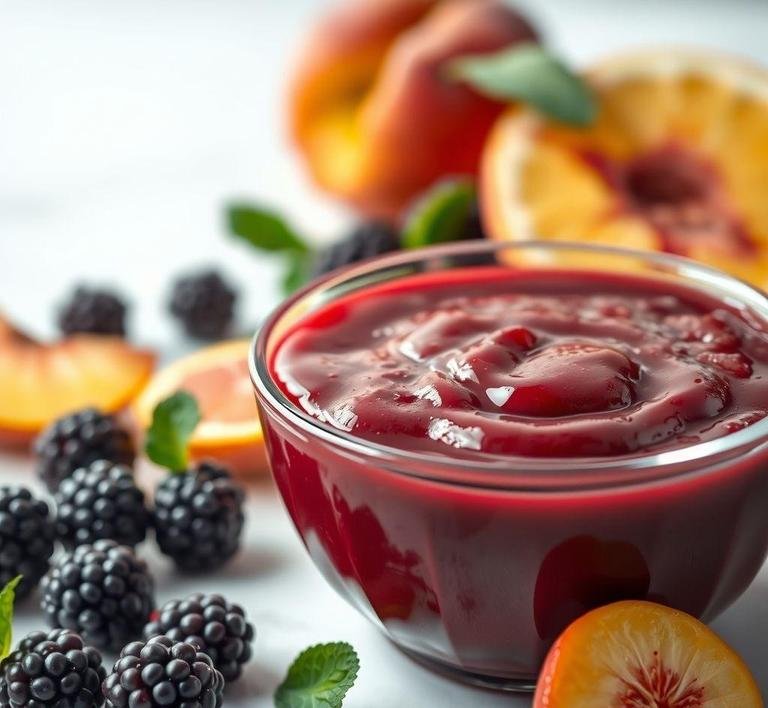Jamie Oliver’s Cumberland Sauce is a vibrant, tangy condiment often paired with roasted meats, particularly game, sausages and cold cuts. It’s a British classic that brings together a sweet and spicy kick, thanks to a unique blend of fruit and spices. The sauce is known for its complex balance: it’s both savory and sweet with a gentle heat, making it the perfect foil for rich meats.
The dish originally hails from the Cumberland region of England and it has a history rooted in the traditions of the British upper class. The key to its charm is the fusion of zesty orange and red currants, often enhanced with mustard and a dash of port. Jamie’s version of the sauce captures this traditional essence but adds a bit of flair and simplicity.
It’s not just a sauce, though. it’s an experience. One spoonful and you’re hit with a medley of flavors that can elevate even the simplest of meals. The sweet and sour notes work together seamlessly to create something memorable.
Jamie Oliver Cumberland Sauce Recipe
Ingredients Needed
- Red Currant Jelly (or Jam): The base of the sauce. It gives the sauce its sweetness and sticky consistency.
- Orange Zest & Juice: This adds a sharp citrus element that balances the sweetness of the jelly.
- Dijon Mustard: A touch of sharpness and heat which brings a bit of bite to the sauce.
- Port (or Red Wine): A splash of port adds depth and richness, bringing everything together.
- Ground Ginger: The warming heat of ginger complements the sweetness and adds a layer of complexity.
- Ground Allspice: A fragrant spice that adds warmth and a slight pepperiness.
- Freshly Ground Black Pepper: For an extra layer of heat and to balance the sweetness.
- Fresh Thyme: Adds an earthy, herbaceous note that cuts through the richness of the sauce.
Equipment Needed
Making Jamie Oliver’s Cumberland Sauce doesn’t require any fancy kitchen gadgets. You’ll need:
- Saucepan: A medium-sized saucepan will do as it’s large enough to cook the sauce without it bubbling over.
- Wooden Spoon: For stirring and preventing the sauce from sticking to the pan.
- Grater/Zester: To zest the orange. A microplane grater will give you the finest zest.
- Measuring Spoons: For accurate measurements of the spices and mustard.
- Strainer (optional): If you prefer a smoother sauce, you can strain it to remove any bits of zest or herbs.
How To Make Jamie Oliver’s Cumberland Sauce
-
Prep the Ingredients:
Begin by zesting the orange and squeezing its juice. This is where the bright citrusy flavor starts to shine. Measure out the red currant jelly, mustard and port. You can adjust the amount of port based on how boozy you want your sauce to be.
-
Heat the Saucepan:
Place your saucepan on medium heat. Add the red currant jelly and let it melt gently into a liquid. Stir it occasionally to ensure it doesn’t stick to the bottom.
-
Add the Flavorings:
Once the jelly has melted, add the orange zest and juice, Dijon mustard, ground ginger, allspice and a pinch of freshly ground black pepper. Stir well to combine. The mixture will start to thicken and the smell of the spices and citrus will start to fill the kitchen.
-
Pour in the Port:
Slowly add the port and continue to stir. You want the sauce to simmer gently, so reduce the heat slightly. The port will deepen the flavor of the sauce and give it a rich, slightly sweet undertone.
-
Simmer and Stir:
Let the sauce simmer for 10-15 minutes, stirring occasionally. You’ll notice it thickening up and the flavors will meld together into a beautiful, glossy consistency. If you prefer a smoother sauce, now’s the time to strain it through a fine mesh sieve.
-
Taste and Adjust:
Give your Cumberland sauce a taste. Does it need more heat? A little more pepper? Or maybe a touch more orange juice for acidity? Adjust it to your liking.
-
Serve:
Once the sauce is ready, pour it over your favorite meat. Jamie Oliver often recommends it with roast meats, particularly sausages, roast beef or game birds. But it’s equally delightful drizzled over cold cuts or even a charcuterie board.
What I Learnt

One of the biggest takeaways from making Jamie Oliver’s Cumberland Sauce is how the combination of sweet, savory and spicy elements can elevate a simple meal. The port adds a sophistication to the sauce while the red currant jelly keeps it accessible with its familiar sweetness. The mix of spices creates a harmony that’s bold but not overwhelming.
Also, I learned how flexible this sauce can be. While it has a classic foundation, you can tweak it to suit your personal taste. Want a bit more heat? Add extra mustard or even some chili flakes. Not a fan of port? Try red wine or even a splash of balsamic vinegar for acidity.
The fact that it’s so easy to make yet tastes so intricate makes it a fantastic go-to for impressing guests or enhancing a weeknight meal. It’s the type of sauce that instantly adds a sense of occasion.
Recipe Tweaks For Jamie Oliver’s Cumberland Sauce
Jamie Oliver’s Cumberland Sauce is a delightful blend of sweet, tangy and slightly spicy flavors that elevates meats, particularly game meats, sausages and terrines. However, there are a few simple tweaks you can make to really personalize the recipe and tailor it to your taste or the ingredients you have on hand.
-
Add a Touch of Spice
While the original recipe calls for Dijon mustard and a bit of cayenne pepper, if you love a more pronounced heat, you can kick it up with some fresh chili or a dash of hot sauce. A small spoonful of horseradish adds a unique twist, balancing the sweetness with a sharp, zesty punch.
-
Fruit Variations
Traditional Cumberland sauce often features orange zest and juice but swapping in other citrus fruits like blood oranges or lemons can change the flavor profile subtly. You can even try adding a few tablespoons of cranberry sauce or finely chopped dried apricots for added richness and complexity.
-
Herbal Notes
The recipe typically uses rosemary or thyme but if you want something a little different, consider experimenting with sage or tarragon. These herbs bring in an aromatic lift and can make the sauce feel a bit more seasonal, like a nod to autumn or winter.
-
Wine or Spirits Infusion
A splash of red wine, port or brandy can enhance the sauce’s depth. If you’re making it for a dinner party, the alcohol will also add a layer of sophistication that matches well with rich meats. Just simmer the alcohol down to concentrate the flavors.
-
Sweetness Balance
If you find the original sauce too sweet or too tangy, you can adjust the sugar level to suit your taste. Some people even add a small drizzle of honey or maple syrup to bring out the sweetness without making it too sugary.
-
Vinegar Choices
Apple cider vinegar is commonly used but you could also try white wine vinegar or sherry vinegar. The different types of vinegar will add slight nuances, either making the sauce more mellow or sharper in taste.
Storage Tips For Leftovers
Cumberland sauce, if you have leftovers, stores quite well which is great because the flavors only deepen after a day or two. Here’s how to keep it fresh:
-
Cooling and Storing
Allow the sauce to cool completely before refrigerating. If stored while hot, it can encourage bacterial growth. Once cooled, transfer it into an airtight container to prevent it from absorbing odors from other foods in the fridge.
-
Refrigeration
Store in the fridge for up to a week. Because it’s made with vinegar and mustard, the sauce is naturally preserved to some extent. But always check for any signs of spoilage. if the sauce starts to smell sour or unusual, it’s better to discard it.
-
Freezing
If you have a lot left over, Cumberland sauce can be frozen. Place it in a freezer-safe container or ice cube trays for easy portioning. When you’re ready to use it, just thaw it overnight in the fridge and reheat gently. Do note that the texture may slightly change after freezing but the flavor should remain intact.
-
Reheating
When reheating, do so slowly over low heat. This prevents any of the delicate flavors from getting lost in the process. If it thickens too much during storage, you can always add a splash of water, stock or a bit more vinegar to adjust the consistency.
What To Eat With Jamie Oliver’s Cumberland Sauce?
The beauty of Cumberland sauce is its versatility. It’s the perfect complement to meats but don’t be afraid to pair it with unexpected dishes for a fresh twist.
-
Classic Meats
Of course, it pairs wonderfully with roasted game birds like pheasant or duck.If you’re grilling sausages. Even a simple roast chicken can feel elevated with the addition of this sweet and tangy sauce.
-
Cheese Platters
Don’t just think of it as a meat sauce! It also works beautifully with strong cheeses, like blue cheese or sharp cheddar. Serve it alongside a cheese platter for a delightful contrast between the richness of the cheese and the tang of the sauce.
-
Cold Cuts
Cumberland sauce is a great companion to charcuterie. If you’re serving a variety of cured meats-like salami, prosciutto or terrine. this sauce acts as a perfect counterbalance to the saltiness and fattiness of those meats.
-
Grilled Vegetables
While meats are the obvious choice, it can also enhance grilled vegetables. Think charred bell peppers, zucchini or even roasted beets. The sauce gives a zingy contrast to the earthiness of the vegetables.
-
Burgers
Switch up your usual burger toppings by adding Cumberland sauce. It pairs incredibly well with beef, lamb or chicken burgers, especially if you’re adding a tangy cheese like goat cheese or aged cheddar.
-
Potatoes
A spoonful of Cumberland sauce drizzled over roasted potatoes or mashed potatoes can make a simple side dish feel extraordinary. It also works as a dip for crispy fries if you’re in the mood for a more casual pairing.
FAQs
What Ingredients Do I Need For Jamie Oliver’s Cumberland Sauce?
You’ll need orange, lemon, red currant jelly, Dijon mustard, Worcestershire sauce, and a few more simple pantry staples.
How Long Does It Take To Make Jamie Oliver’s Cumberland Sauce?
It only takes about 15 minutes to whip up! Super quick and easy.
What Dishes Does Jamie Oliver Suggest Serving Cumberland Sauce With?
It’s perfect with meats like roast beef, sausages, or even a hearty turkey. It adds a great kick!


